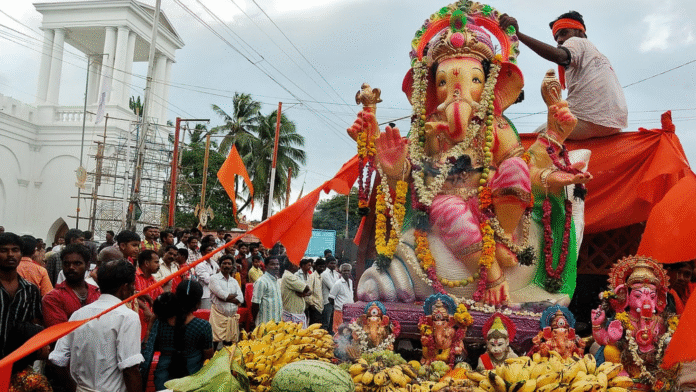Ganesh Chaturthi is one of the most widely and joyously celebrated Hindu festivals across India, marking the birth of Lord Ganesha, the beloved elephant-headed deity of wisdom, prosperity, good fortune, and removal of obstacles. Among the states of India, Karnataka stands out for its rich, vibrant, and culturally nuanced celebration of Ganesh Chaturthi, locally known as “Ganesh Habba.” This festival is not merely a religious observance; it is a deeply rooted cultural phenomenon combining spirituality, community bonding, art, and tradition over a span of typically 10 days. The Karnataka style of Ganesh Chaturthi presents a unique blend of ritualistic solemnity with colorful, lively festivities that reflect the state’s artistic heritage, rural customs, and social ethos.
Cultural Significance of Ganesh Chaturthi in Karnataka
Ganesh Chaturthi honors the birthday of Lord Ganesha, who is the son of Shiva and Parvati. He is revered as the “Vighnaharta” or the remover of obstacles and the god who brings wisdom (“buddhi”), prosperity (“riddhi”), and spiritual attainment (“siddhi”). The festival in Karnataka is more than a spiritual event; it is an expression of the people’s devotion and respect for tradition that has been passed down through generations, imbibing local customs, language, and artistry.
Karnataka’s distinct cultural ethos is palpably woven into the celebrations. From the initial welcoming of Ganesha idols to the culmination in their immersive farewell, each day is marked by ritualistic pujas (prayers), community singing of hymns, classical music, folk dance performances, and dramatic enactments of mythological stories surrounding Lord Ganesha and his divine family. The state embraces not only religious rites but also the celebration of its rich cultural heritage through storytelling, music, and communal feasts that bring together people from all walks of life.
This festival embodies the social harmony, community spirit, and artistic expression inherent to Karnataka’s cultural fabric. Eminent cultural programs organized during the 10-day celebration highlight the heritage of classical music forms like Carnatic music, traditional dance forms like Yakshagana, and folk arts, which accentuate the devotional mood and collective participation of communities.
Duration and Rituals: The Ten Days of Celebration
Typically, Ganesh Chaturthi celebrations in Karnataka last for 10 days, beginning from the fourth day (Chaturthi) of the Hindu month of Bhadrapada (August/September) and culminating on the day of Anant Chaturdashi. The timeline is significant as each day carries sacred rituals, prayers, and cultural observances leading up to the grand celebration and immersion (visarjan) of the idol.
Beginning the Festival
The practical and spiritual preparations for Ganesh Chaturthi begin days before the actual Chaturthi. Homes and temples are cleaned and decorated, often with flowers, banana leaves, rangoli (decorative art on floors), and oil lamps. In Karnataka, a special cultural significance is accorded to the day before Ganesh Chaturthi, known as “Gowri Habba” or “Gowri Ganesha,” dedicated to Goddess Gowri (Parvati), the mother of Lord Ganesha. Primarily observed by women, this festival includes worshipping the goddess for familial prosperity and the well-being of their children. Women dress in traditional attire, create turmeric idols of Gowri or use ready-made ones, and decorate them with mango leaves and flowers. This practice of celebrating Goddess Gowri prior to Ganesha uniquely characterizes Karnataka’s observance compared to many other Indian states.
Installation and Worship of Ganesha Idols
On Ganesh Chaturthi day, devotees bring home or to community spaces colorful and intricately crafted clay idols of Lord Ganesha, symbolizing his presence among them. The installation ceremony (“pranapratishtha”) awakens the divine spirit within the idol through sacred chants and rituals. The idols vary in size, from small household murti to massive public installations set up by government bodies or neighborhood associations. The Karnataka government itself installs enormous Ganesha idols in decorated pandals or temporary structures, creating a festive ambiance. These pandals are adorned with natural elements such as banana saplings, flowers, and strings of lights, creating a vibrant spectacle that attracts devotees and tourists alike.
Daily worship includes devotional chanting of Vedic hymns, aartis (ceremonial songs with lamps), and offerings of sweets like modak, believed to be Ganesha’s favorite as well as other local delicacies such as kosambi, gojju (a type of sweet chutney), and payasam. These offerings are often served on banana leaves, respecting traditional customs.
Community and Cultural Activities
The Ganesh Chaturthi festival is also marked by grand community involvement. In cities like Bengaluru and Mysuru, elaborate cultural programs unfold, including classical music recitals, folk dance presentations like Yakshagana (a traditional theatre form of Karnataka), and dramatic enactments depicting Ganesha’s stories and lessons in humility, wisdom, and devotion. These activities foster social unity and create a platform for cultural preservation and transmission across generations.
In rural Karnataka, Ganesh Chaturthi incorporates agrarian rituals where farmers pray for abundant harvests, linking the festival’s spiritual themes to the livelihood and cultural identity of village communities.
Visarjan: The Farewell Ritual
The culmination of Ganesh Chaturthi lies in the ritual immersion or Visarjan of the Ganesha idols on the tenth day, called Anant Chaturdashi. This ritual symbolizes Lord Ganesha’s journey back to his celestial abode, taking away the misfortunes of his devotees and leaving blessings for prosperity and wisdom. The immersion is solemn yet celebratory, with devotees accompanying the procession with devotional songs, dancing, and chanting, infusing the event with collective joy and communal bonding. In Karnataka, immersion usually takes place in local water bodies, lakes, or rivers, reflecting reverence for nature and the cycle of life.
Distinct Cultural Elements of Karnataka’s Ganesh Chaturthi
Though Ganesh Chaturthi is celebrated widely across India, Karnataka has its own unique cultural identity for the festival, distinguished by several aspects:
- Ganesh Habba: The local name “Ganesh Habba” literally means “Ganesh Festival” in Kannada, emphasizing the festival as a homegrown cultural event.
- Gowri Habba Preceding Ganesh Chaturthi: The special observance of Gowri Habba, focusing on Goddess Parvati, stands out as a unique prelude to the Ganesh festival, particularly involving women’s participation and traditional rituals tied to familial prosperity and agricultural life.
- Culinary Traditions: Karnataka offers distinctive culinary fare during the festival. Modak is widely popular, but local sweets like kosambi (a type of fried sweet) and gojju make the food offerings rich and uniquely regional. Meals served on banana leaves also carry cultural significance, symbolizing purity and auspiciousness.
- Artistic Expressions: Incorporation of Karnataka’s native art forms such as Yakshagana, classical Carnatic music concerts, and regional folk dances enrich the cultural texture of the festival. These performances not only entertain but also educate the community about mythological narratives and moral values associated with Lord Ganesha.
- Decorative Style: The use of natural elements such as banana saplings, flower garlands, and eco-conscious decorations in pandals reflects Karnataka’s connection with nature and sustainable practices during festivals.
- Community Spirit: Karnataka’s celebrations emphasize collective participation—neighborhoods, local clubs, and government bodies collaborate to organize events, install large idols, and manage festivities, strengthening social bonds and cultural identity.
Comparison with Other Regional Celebrations
While Maharashtra’s Ganesh Chaturthi is perhaps the most famous for its large-scale public celebrations with massive idol immersions and exuberant street processions, Karnataka balances grandeur with cultural depth and community focus. Maharashtra’s celebrations can be more urban-centric with extensive public pandals and theatrical events; Karnataka maintains a closer tie to traditional arts and rural elements as well.
In Tamil Nadu, Ganesh Chaturthi is celebrated more privately with modest idol installations and simpler rituals, emphasizing personal devotion over public festivities. Tamil Nadu also shares the tradition of Gowri Ganesha but with fewer large public events than Karnataka. The food offerings and rituals in Tamil Nadu also differ, with dishes like kozhukattai featured prominently.
Northern Indian states observe Ganesh Chaturthi too, but it is not as culturally dominant or elaborate as it is in the southern states like Karnataka and Maharashtra.
Thus, Karnataka’s Ganesh Chaturthi is a compelling blend of the spiritual and the cultural, the traditional and the community-oriented, setting it apart from celebrations in the rest of India.
Contemporary Significance and Evolving Practices
In modern Karnataka, Ganesh Chaturthi continues to thrive as a festival that fosters devotion, cultural pride, and social cohesion. Alongside traditional practices, there is a growing awareness of eco-friendly celebrations, with emphasis on clay idols that dissolve easily in water to protect aquatic environments.
Government initiatives and cultural organizations actively promote public awareness campaigns for sustainable practices during immersion and encourage participation in cultural events linked to the festival, ensuring its vibrancy for future generations.
Ganesh Chaturthi in Karnataka is a timeless tradition that honors ancient myths and legends while serving as a platform for cultural celebration and communal harmony in today’s diverse society.
In summary, Ganesh Chaturthi in Karnataka—celebrated as Ganesh Habba—is a culturally rich, multi-day festival deeply rooted in devotion, art, tradition, and community. From the culturally unique Gowri Habba prelude to the traditional immersion rituals, Karnataka’s celebration blends solemn religious practices with vibrant cultural performances and social unity, marked by distinctive culinary and artistic expressions. Spanning 10 days, it encapsulates the essence of Karnataka’s spiritual and cultural identity, making Ganesh Chaturthi not just a festival, but an enduring cultural phenomenon.
Embracing Eco-Friendly Practices in Karnataka’s Ganesh Chaturthi
In recent years, Karnataka has embraced a growing consciousness about environmental sustainability, shaping how Ganesh Chaturthi is celebrated across the state. Traditionally, idols of Lord Ganesha were crafted from natural clay, but the popularity of Plaster of Paris (PoP) idols led to significant environmental concerns, notably water pollution during the immersion ceremony. Recognizing this, local authorities, NGOs, and community organizers in Karnataka have actively promoted eco-friendly celebrations to harmonize spirituality with ecological responsibility.
The Bruhat Bengaluru Mahanagara Palike (BBMP), Karnataka’s capital city’s municipal corporation, has instituted stringent guidelines regulating the materials used in crafting Ganesha idols for public installations. They prohibit Plaster of Paris, thermocol, and toxic chemical paints, urging the use of biodegradable clay and organic colors that dissolve naturally in water bodies without leaving harmful residues. Additionally, immersive ceremonies are increasingly held in artificial tanks and specially designated eco-friendly immersion sites to safeguard the rivers, lakes, and other aquatic ecosystems from contamination.
One of the innovative strides in Karnataka is the introduction of “Bappa’s Tree, eco-friendly Ganesha idols embedded with seeds that, after immersion or home-based rituals, can be planted to grow into trees. This novel practice symbolizes regeneration and the cycle of life, intertwining the spiritual essence of Ganesh Chaturthi with active environmental stewardship. These biodegradable idols are crafted using organic soil blends and natural paints, promoting a green Ganesh Chaturthi that connects devotees deeply with nature and sustainability.
Community-driven initiatives have also arisen, encouraging residents to make their own clay idols through workshops and competitions, especially in urban residential complexes in Bengaluru and other cities. Such activities foster a hands-on devotional experience while educating younger generations about sustainability and traditional crafts. Societies organize clay idol-making contests for children, demonstrating how eco-friendly customs and cultural participation nurture a responsible mindset from an early age.
Social and Community Impact
Beyond religious observance, Ganesh Chaturthi in Karnataka plays a pivotal social role by fostering unity, philanthropy, and cultural cohesion. The festival transcends caste, class, and community lines, bringing together families, neighbours, artisans, and producers in collective joyous celebrations. This spirit of togetherness is evident in the numerous public events, cultural programs, and fairs organized across urban and rural areas.
A distinctive social impact is visible through fundraising and charitable work conducted during the festival. Many Ganesh Chaturthi mandals and community groups allocate proceeds from cultural shows, food sales, and sponsorships towards supporting education initiatives, healthcare camps, and welfare projects for underprivileged sections of society. This philanthropic dimension reflects Lord Ganesha’s role as a protector and benefactor beyond the spiritual realm, weaving social good into the fabric of the festivities.
Volunteerism is another hallmark of Karnataka’s celebrations. Thousands of volunteers come forward to assist with event management, decorations, distribution of prasad (holy food), and organizing eco-friendly immersion setups. Their efforts ensure smooth conduct of rituals and cultural shows, while also promoting awareness about waste management and environmental conservation. This culture of selfless service deeply enriches the community spirit and reinforces the festival’s core values of compassion and cooperation.
Unique Cultural Practices: Non-Vegetarian Offerings in Certain Communities
While Ganesh Chaturthi is generally associated with vegetarian offerings such as modak, ladoos, and fruits, Karnataka houses diverse cultural practices that occasionally diverge from this norm. One fascinating example is the tradition followed by the Savji community from Hubballi, who observe Ganesh Chaturthi with a distinct non-vegetarian culinary offering post the main festival day. Alongside the customary vegetarian delicacies, they include dishes like mutton chops, chicken curry, fish fry, and biryani in their rituals. This centuries-old custom, known as “Iliwara,” highlights the pluralistic and culturally rich nature of Karnataka, where diverse communities maintain their unique methods of devotion while collectively celebrating the larger Hindu festival.
Devotional Practices and Home Celebrations
In Karnataka, home celebrations during Ganesh Chaturthi carry immense devotional fervor. Families perform elaborate worship ceremonies that extend beyond the initial installation of the Ganesha idol. Daily rituals include chanting sacred mantras like “Om Gan Ganapataye Namah” and “Vakratunda Mahakaya,” performing the Shodashopachara Puja (16-step worship ritual), and singing devotional songs that praise Ganesha’s virtues and mythological exploits. Lighting oil lamps and incense sticks enhances the ambiance, creating a serene spiritual environment in the household.
Maintaining the sanctity of the space is crucial during the ten days. Devotees offer fresh flowers, durva grass (a sacred herbal offering), and fruits to the idol, while also preparing traditional sweets such as modak, kosambi, and payasam for prasad. The evening aartis are moments of communal prayer and family bonding, deepening the sacred connection with the deity.
Economic Influence and Artisan Support
Ganesh Chaturthi in Karnataka is not only a cultural and religious phenomenon but also a significant economic driver. The festival sustains a wide spectrum of local artisans, craftsmen, and small business owners involved in producing clay idols, decorations, sweets, flowers, and ritual items. By choosing handmade and eco-friendly idols produced by rural artisans, devotees help preserve traditional crafts that might otherwise face decline in the age of mass industrial production.
Moreover, the demand surge during Ganesh Chaturthi invigorates local markets and creates seasonal employment, contributing to the state’s economic vitality. The festival also encourages handicraft fairs and cultural marketplaces that showcase Karnataka’s artistic heritage, offering a platform for indigenous art forms and craftspeople to gain recognition and livelihood.



